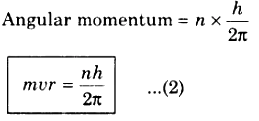Bohr Model for Hydrogen Atom and Hydrogen Like Ions:
The drawbacks of Rutherford model were removed by Niels Bohr in 1913. Bohr proposed a new atom model. He applied the quantum theory of radiation, as developed by Max Planck and Einstein, to the Rutherford model.
Following are the postulates of the Bohr’s theory.
1. An atom consists of a small and massive central core, called nucleus around which planetary electrons are revolving. The centripetal force required for their rotation is provided by the electrostatic attraction between the electrons and the nucleus. While revolving in the permissible orbits, an electron does not radiate energy. These non-radiating orbits are called ‘stationary orbits’
Fcoulomb = Fcentripetal
If an electron moves around the nucleus of the charge, Ze in the nth stable orbit, then
\(\frac{k(Z e) e}{r_{n}^{2}}=\frac{m v_{n}^{2}}{r_{n}}\)
Where rn is the radius of nth orbit and vn is the velocity of electron in nth orbit. So,
Then the frequency v of the emitted or absorbedWhere rn is the radius of nth orbit and vn is the velocity of electron in nth orbit. So,
\(\frac{k(Z e) e}{r_{n}^{2}}=\frac{m v_{n}^{2}}{r_{n}}\) ……………… (i)
2. According to the second postulate the electrons are permitted to revolve only in those orbits in which the angular momentum of an electron is an integral multiple of \(\frac{n}{2 \pi}\), h being Planck’s constant.
These orbits are called stable orbits. If mass of electron is m, orbital velocity is v and radius of orbit is r, then

3. An atom can emit or absorb radiation in the form of discrete energy photons only when an electron jumps from a higher to a lower orbit or from a lower to a higher orbit, respectively. If En1 and En2 are the energies associated with these permitted orbits.

Then the frequency v of the emitted of absorbed were radiation is given by,
En2 – En1 = hv = \(\frac{h c}{\lambda}\)
This is known as Bohr’s frequency condition
Total Energy of Electron in nth Orbit
Total energy (El) in any stable orbit class is equal to the sum of the kinetic energy and potential energy. Kinetic energy of electron.
Kn = \(\frac{1}{2}\) mv2
From equation (2) in Article number 14.3.1
v2 = \(\frac{1}{4 \pi \varepsilon_{0}} \frac{Z e^{2}}{m r_{n}}\)


Again put the value of rn from equation (4)
